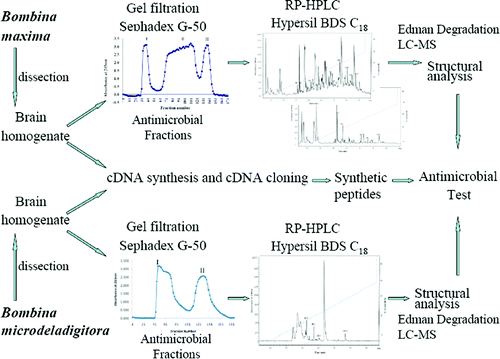两种两栖动物脑中发现多种抗菌肽
来源::《蛋白质组研究期刊》
作者:赖仞等
时间:2011-04-08
|
|
|
|
大量的抗菌肽已经从两栖动物的皮肤中发现,但从动物脑中很少报道。中国科学院昆明动物研究所赖仞研究员领导的课题组采用蛋白质组学结合基因组学的手段,从两种两栖动物(大蹼铃蟾和微蹼铃蟾)脑中识别了59种新抗菌肽分子,该研究表明两栖动物脑是重要的抗菌肽分子资源库。
该研究结果发表在国际知名期刊《蛋白质组研究期刊》(J Proteome Res.) 上,同时美国化学学会新闻周刊以“蟾蜍脑是发掘强力抗微生物武器的宝库”(Toad brains are a treasure trove of powerful germ-fighters)为题对该成果作了专门评述。
There are Abundant Antimicrobial Peptides in Brains of
Two Kinds of Bombina Toads
J. Proteome Res., 2011, 10 (4), pp 1806–1815 DOI: 10.1021/pr101285n

Abstract It is well-known that there is a large amount of antimicrobial peptides in amphibian skins but few antimicrobial peptides are found in amphibian brains. Twenty-two and four antimicrobial peptides were purified and characterized from the brain homogenate of Bombina maxima and B. microdeladigitora, respectively. One hundred fifty-eight cDNA clones encoding 79 antimicrobial peptides were isolated from brain cDNA libraries of B. maxima and B. microdeladigitora. These antimicrobial peptides belong to two peptide groups (maximin and maximin-H). Twenty of them are identical to previously reported antimicrobial peptides (maximin 1−8, 10, 11, maximin H1, 3−5, 7, 9, 10, 12, 15, 16) from B. maxima skin secretions. Fifty-nine of them are novel antimicrobial peptides. Some of these antimicrobial peptides showed strong antimicrobial activities against tested microorganism strains including Gram-positive and -negative bacteria and fungi. The current diversity in peptide coding cDNA sequences is, to our knowledge, the most extreme yet described for any animal brains. The extreme diversity may give rise to interest to prospect the actual functions of antimicrobial peptides in amphibian brains.




